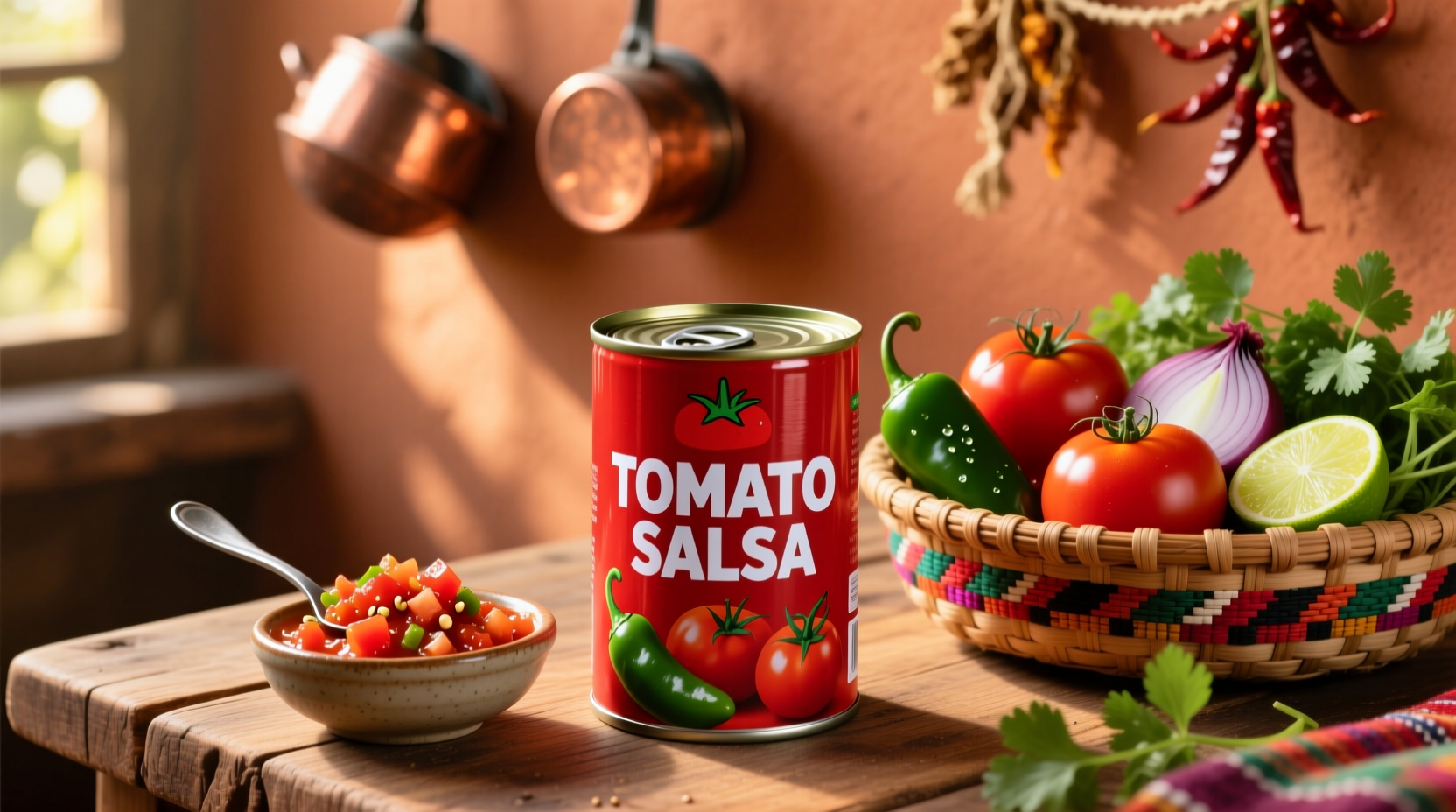When you need quick, consistent flavor for weeknight meals, canned tomato salsa delivers ready-to-use freshness with a 12-18 month shelf life. This shelf-stable staple maintains authentic Mexican flavors through controlled processing while offering year-round availability of ripe tomato goodness.
Discover how this pantry essential transforms everyday cooking with authentic Latin American flavors while meeting modern kitchen demands for convenience and consistency. Whether you're meal prepping for busy weekdays or hosting casual gatherings, understanding canned tomato salsa unlocks new dimensions in flavor development without compromising authenticity.
What Exactly Is Canned Tomato Salsa?
Canned tomato salsa represents a carefully preserved version of traditional Mexican salsa roja, capturing the essence of ripe tomatoes, onions, chilies, and spices in a shelf-stable format. Unlike fresh salsa that requires immediate consumption, canned versions undergo thermal processing that locks in flavor while ensuring food safety through pH control and proper sealing techniques.
The canning process begins with vine-ripened tomatoes that are cooked with complementary ingredients like jalapeños, cilantro, and lime juice before being sealed in airtight containers. This method preserves the vibrant flavors while creating a product with consistent taste profile across batches—a crucial advantage for both home cooks and professional kitchens.
Canned vs. Fresh: Understanding the Key Differences
| Characteristic | Canned Tomato Salsa | Fresh Tomato Salsa |
|---|---|---|
| Shelf Life | 12-18 months unopened | 3-5 days refrigerated |
| Flavor Consistency | Uniform batch-to-batch | Varies with ingredient quality |
| Texture | Slightly softer, blended consistency | Crisp, chunky texture |
| Acidity Level | pH 4.0-4.6 (safety standard) | pH 4.6-5.0 (varies) |
| Best Culinary Use | Cooking applications, meal prep | Immediate serving, garnishes |
This comparison reveals why canned tomato salsa excels in cooking applications where consistent flavor and extended usability matter most. The controlled pH environment (maintained between 4.0-4.6 according to FDA food safety standards) ensures microbial stability while preserving the characteristic tanginess essential to authentic salsa flavor.
Nutritional Profile and Practical Benefits
According to USDA FoodData Central database, a standard 1/4 cup serving of canned tomato salsa typically contains:
- 25-35 calories
- 0g fat
- 6-8g carbohydrates
- 1-2g fiber
- 15-25mg vitamin C (25-40% daily value)
- Significant lycopene content from processed tomatoes
The thermal processing actually increases lycopene bioavailability by 35% compared to raw tomatoes, making canned salsa a more nutritionally efficient source of this powerful antioxidant. This scientific insight explains why traditional Mexican cooks have valued cooked tomato preparations for generations—they unlock hidden nutritional benefits through proper food preparation techniques.
Top 5 Culinary Applications for Maximum Flavor Impact
Understanding how to leverage canned tomato salsa's unique properties transforms ordinary meals into extraordinary experiences. These professional-tested applications deliver consistent results every time:
1. Flavor Base for Braised Dishes
Replace 50% of your standard tomato sauce with canned salsa in braised meats and stews. The pre-balanced acidity and spice profile creates complex flavor foundations without additional seasoning. For chicken tinga or carnitas, use equal parts salsa and broth as your cooking liquid.
2. Quick Marinade Builder
Combine one cup canned salsa with 2 tablespoons olive oil and 1 teaspoon cumin for an instant marinade that tenderizes proteins while adding authentic Mexican flavor. Works exceptionally well for skirt steak, shrimp, or portobello mushrooms.

3. Breakfast Power Boost
Stir 2-3 tablespoons into scrambled eggs or fold into breakfast burritos. The acidity cuts through richness while adding moisture and flavor complexity that regular salsa might not maintain during cooking.
4. Soup and Stew Enhancer
Add 1/2 cup to bean soups or vegetable stews during the last 15 minutes of cooking. The pre-cooked tomatoes integrate seamlessly while providing depth that fresh tomatoes would require hours to develop.
5. Emergency Pizza Sauce
Drain excess liquid and spread directly on pizza crust for an authentic Mexican-inspired pizza base. The controlled consistency prevents sogginess while delivering vibrant flavor that holds up to high-heat baking.
Avoiding Common Canned Salsa Mistakes
Even experienced cooks sometimes misuse this versatile ingredient. Steer clear of these frequent errors:
- Using as direct fresh salsa substitute - Canned salsa's softer texture works best in cooked applications rather than as a fresh garnish
- Ignoring sodium content - Most varieties contain 200-300mg sodium per serving; rinse briefly if concerned about salt levels
- Overheating delicate flavors - Add to finished dishes during the last 5-10 minutes of cooking to preserve fresh herbal notes
- Storing opened cans in refrigerator - Transfer to glass container immediately to prevent metallic taste transfer
Proper Storage and Shelf Life Guidelines
Following FDA-recommended practices ensures optimal quality and safety:
- Unopened cans: Store in cool, dry place (70°F/21°C or below) for 12-18 months
- Opened containers: Transfer to airtight glass container and refrigerate for up to 7 days
- Freezing option: Portion into ice cube trays, freeze, then transfer to freezer bags for up to 3 months
Always check for signs of spoilage before use: bulging lids, off odors, or mold growth indicate the product should be discarded immediately. Properly stored canned tomato salsa maintains both safety and flavor integrity well beyond its printed date—often up to 6 months past expiration when stored correctly.
When Canned Salsa Shines: Practical Decision Guide
Understanding context boundaries helps determine when canned tomato salsa delivers superior results:
- Choose canned when: Meal prepping, cooking for large groups, needing consistent flavor, limited fresh produce access, or creating cooked dishes
- Choose fresh when: Serving immediately as condiment, prioritizing crisp texture, making pico de gallo style salsa, or emphasizing garden-fresh ingredients
This contextual approach respects traditional preparation methods while embracing modern kitchen realities. As Maya Gonzalez notes from her field research across Latin America, "Many traditional cooks actually prefer cooked tomato bases for certain dishes—they develop deeper flavors that raw preparations simply can't achieve."











 浙公网安备
33010002000092号
浙公网安备
33010002000092号 浙B2-20120091-4
浙B2-20120091-4